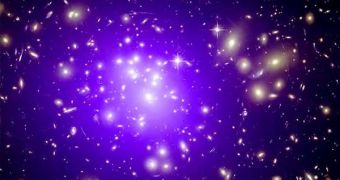The oldest galaxy in the known Universe appeared when the Universe was still reeling from the shock of the Big Bang. Now, in-depth studies of the object indicate that it and others like it may have played a role in eliminating the “atomic fog” permeating the Cosmos.
The cosmic structure was discovered more than 12.8 billion light-years away from Earth, which means that it began to form when the Universe was only 150 to 300 million years old.
Astronomers usually refer to that period as the dark ages, simply because there were no light sources that penetrated this veil. It was only after the Cosmos cooled sufficiently that hydrogen gas and cosmic dust could come together to create the earliest stars.
In the latest study to be conducted on the small, yet distant galaxy, a team of experts in Europe and the United States found that early galaxies may have dispersed a type of atomic fog made of hydrogen.
As the Universe was cooling, some 380,000 years after the Big Bang, protons and electrons came together to form the hydrogen atom, which then proceeded to block any sort of light that may have been around at the time.
After the first stars and galaxies appeared, their radiation contributed to ionizing the entire Universe, allowing light to shine through unimpeded, and eventually make its way to us. This is called the reionization epoch, experts say.
Until now, astronomers had no idea that many stars and galaxies may have existed at that time, and that they may have also contributed to bringing an end to the dark ages, Daily Galaxy reports.
This conclusion was derived from the new study, which was carried out by French scientists at the University of Lyon. They were led by expert astronomer Johan Richard. The group used gravitational lensing to get a better view of the target galaxy.
The object is small, measuring only a few light-years across, and has a mass of 6 billion Suns. For comparison, the Milky Way is 100,000 light-years across, and tips the scale at 100 billion solar masses.
“Gravitational lensing is the magnification of distant sources by foreground structures,” California Institute of Technology (Caltech) Steele Family Professor of Astronomy Richard Ellis says.
“By looking through carefully selected clusters, we can locate galaxies seen at unprecedented distances, corresponding to a time when the universe was only 500 million years old, or less than four percent of its present age,” he adds.
“That's why we're using gravitational lensing to look for fainter objects, because if they're very numerous, then they would have reionized the intergalactic medium,” the expert goes on say.
A study detailing the findings has been submitted for publication to the journal Monthly Notices of the Royal Astronomical Society Letters.

 14 DAY TRIAL //
14 DAY TRIAL //